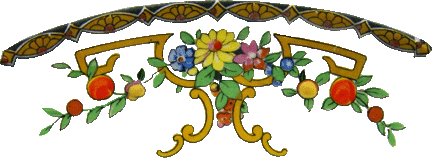

Life
Stories of
Donald Maurice Guild
and
Anne Luella McKinlay Guild
|
my comments & captions in
yellow
|
written by Anne Guild in the mid-1990s, with Brenda |
||||||||
|
Little boys wore dresses then, not a stigma at all. Had Grandad been born four days later, his birth certificate would have said Edmonton, Alberta. The province came into being September 1st, 1905. A first cousin of Grandad's, Mae Guild, born 1900, visited her Uncle Jim's dairy farm - by the North Saskatchewan River near White Mud - when she was five. She remembered a big, idyllic place on a perfect summer day, lots of cows, and tiny baby Don sleeping in his pram. |
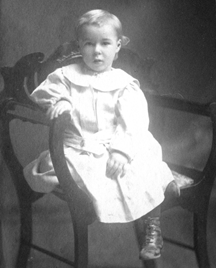 first photo, age two |
Don was born in Edmonton, North West Territories, on August 28, 1905. He was the third and youngest child of James Wesley Guild and Mary (née Horspool) Guild. His dad had the first dairy in Edmonton, selling out to Edmonton City Dairy. |
|||||||
|
Great-Grandma McKinlay told my mom that her pregnancy with Annie had been a difficult one. She said this with a sigh and a head shake, because Annie had been a force of nature from the start. She wore through three sets of knees in her 90 years. Murdoch McKinlay donated a piece of his quarter-section farm for the building of a school in 1910, about the time this photo was taken. His children and the neighbours' would then get proper schooling - a McKinlay priority for their kids, with the hope that they'd go further than their parents' elementary level schooling. 1910, first photo of Annie (on the right) with her sister Sarah, also called Sally and Sal. |
I was born at Stony Plain on January 1st, 1907, at the home of my parents, Leaffie Alberta (nee Imeson) McKinlay and Murdoch McKinlay. Dad had taken up his homestead in 1880, as the second settler in the Stony area, 20 miles west of Edmonton. He build our home in 1895, the first frame house west of Fort Edmonton. It was 60-below zero the day was born, which I was reminded of many times throughout the years. The hired man, Jake Williams had to drive nine miles to inform Dr. Oatway he was needed. Dad gave Jake $1.00 to buy a bottle of whiskey and told him in no way to hurry home. I attended Comet Public School - built in 1910, the year of Halley's Comet - for my first eight grades. |
|
|||||||
|
This letter to Grandma meant a great deal to her. I made quick notes in the mid-1990s when she was telling me about Uncle Dan, her dad's older brother, and other kin. When she was 10, he gave her a table to study at, to encourage her scholarship, which paid off by her becoming a teacher. His help when she was 12 was formative to her becoming a good business woman years later - to give her all and get paid for it. She had read an ad' in a newspaper or magazine about selling perfume,
then getting a prize for selling it. She ordered the perfume, and it arrived,
but somehow (I didn't record this), the neighbouring Graden brothers spilled
the bottles of perfume. Grandma had to pay for them anyway. |
|
|
|||||||
|
Grandad's family, circa 1910 Mary Horspool Guild's sister, Katie Horspool Scarlett, (witnessed to Mary's wedding; better known as Kit), lived in Edmonton. Grandma said that Don went to her house every Friday night for a bowl of boiled beans, with milk added to the mush. |
Don took his high school at Comstock Commercial School in Edmonton, specializing in woodwork, to become an excellent cabinet and finish carpenter. Grandad was immensely fond of his big brother, Gordon Grover, 12 years his senior. His fiesty big sister, Gladys Gertrude, was ten years his senior.
Gordon Grover Guild, circa 1914 |
Glad and Don, 1915, say a sombre goodbye Gordon was killed in action on September 10, 1916. More about this chaper of Grandad's life in the "Guild forebears" webpage. After the death of Don's mother in New Westminster in August 1921, he went back to Edmonton with his father, who married a widow with two grown children, Ida Ellis, in 1922. Shortly after, the three of them went to live in California. In 1924, they returned to Edmonton. Don went to Jasper to live with his sister Gladys Hargreaves and her husband Jack. |
|||||||
|
|||||||||
|
Jasper's main street, as 19-year-old Don photographed it from the train station in 1924. |
Don's first summer there, he worked at the geographic survey crew. Subsequently, he helped build CNR cabins at Mt. Robson and tourist cabins at Berg Lake, and he guided with the Hargreaves company. He had been working at Mt Robson for the Hargreaves Brothers (Frank, George, Roy, and Jack) guiding and outfitting business at their summer lodge. Jack sold out his interest and, with Don, started the Hargreaves and Guild Guiding and outfitting Business in Jasper - brand HG. As the Hargreaves and Guild guiding and hunting business was seasonal, Don worked the rest of the year as a carpenter. Don build himself a good-sized log house at 304 Balsam Street in Jasper, not far from his sister Glad's. |
||||||||
|
Grandad helped construct much of Jasper. During his years there, he worked on every building on Jasper's main street, many homes in town, the log cabins at Jasper Park Lodge, Fred Brewster's Fishing Lodge at Maligne Lake, and other tourist buildings. His "good-sized" house still stands. It's very small by today's standards. |
|
||||||||
|
Grandma, centre, with her family in 1924, in front of their Stony Plain farmhouse. They were "just ready to leave for 'Scona", she wrote. This would be Strathcona, in south Edmonton, where the train station was located, near Strathcona High School. Left to right: younger sister Sarah (Sal), her father, younger sister Florence (Flo), Anne, her grandmother Emma Imeson, and her mother. Grandma McKinlay's mother had come to visit from Seeley's Bay, Ontario - a very special time for the family, which Grandma remembered most fondly. |
|
||||||||
|
the
Normal School graduate, |
I took grade IX at Stony Plain, finishing at Strathcona High in Edmonton, then Normal School in Camrose in 1926-26. I taught for four years, with my last year at Comet School, where I had started my own schooling.
First teaching job, Port View, Alberta |
Anne and Normal School chum, a year or so after grad'. In this and other shots, he has his eye on her, but she wasn't looking back.
|
|||||||
|
Robson Ranch, which Grandad helped build. |
On a weekend visit back to Mt. Robson in 1928, Don met Anne Luella McKinlay. I was filling in my summer holidays (from teaching at one-room schools from September to June) as Social Hostess at the Mt. Robson Ranch. My employer, Mrs. Roy Hargreaves (née Sophia McLean) had boarded with my parents while she taught at Comet School of Stony Plain. She had been my Grade VII teacher. |
Grandma at a Berg Lake cabin, which Grandad had also helped build. |
|||||||
|
Grandad with the ladies at Robson
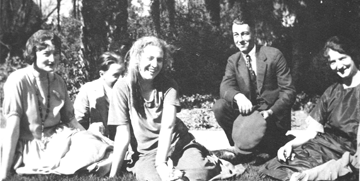 |
|||||||||
|
"Lovingly, Sal & Gord" |
Grandma thought highly of this tall, handsome fellow, two years her senior, met at Camrose Normal. I asked her, in the 1990s, about first meeting Grandad - what happened, what her first impression was. She said, "Oh, I can't remember things like that. It was too long ago ... we just met, it's not important." I said that, at some point, they obviously had caught each other's eye and fell in together, but she said - in front of my husband - that I was just pressing her because I I had been desperate (an "old maid", in her book, of 28) when I took up with my Don. Aiy! Then I asked her about meeting Gordon Botsford, and she said he came to the door of her parents' house when the family was eating dinner, and she answered the door, and he was wearing ... she described his clothing down to the socks! She ran upstairs to her bedroom to change her clothing, and she put on ... she remembered down to those stockings too. But Gord had come calling for Sal, and not long after, surprisingly, they eloped - Grandma's much adored sister married to a very special man. They eloped so she could keep teaching. When the secret of their marriage got out, she had to quit. No married women were hired or kept on staff in those days. |
||||||||
|
Because Don was hard of hearing (the result of childhood illness), he left the Hargreaves and Guild partnership in 1929; guiding had become too unsafe, with many grizzlies on the trails.
|
Grandad couldn't hear bears coming or around the camp at night, which put his customers at extra risk. Jack Hargreaves wouldn't pay out Grandad's half of their shared business bank account, something over $3000 - a lot of money then, especially as the Great Depression set in. Grandma spoke occasionally, and passionately, about this unresolved difficulty, which caused a rift in the family that lasted until after Jack's death. In old age, Grandma enjoyed visiting Glad in her old Jasper home. |
||||||||
|
The
former Great White Mountain, |
Mount Edith Cavell In 1928, Grandad was contracted to build a log chalet at Mt. Edith Cavell, one of few buildings in the world so close to the foot of a hanging glacier. Edith Cavell was a British nurse who, in WWI, served in Belgium. She tended wounded soldiers from both sides. The Germans captured her, tried her quickly, and shot her the next sunrise. She became a great martyr for the Allies, strenthening their resolve against a ruthless foe. |
Early 1920s, the former Ghost Glacier, |
|||||||
|
In 1924, Mrs. Fred Slark, a photographer, had build a small frame Tea House at the end of the road, at the Astoria viewpoint. He died in an avalanche on the Ramparts of Tonquin Valley; his body was never recovered. His wife, Gladys, who had a souvenir shop in Victoria, BC, made her first trip to Jasper to settle his estate. She fell in love with the Cavell site and decided to build a permanent log building at the foot of the glacier, where the road had just been finished. |
Chalet Moraine, spring 1929 |
Chalet Moraine, up and running. The Chalet sat 18 miles from town. To this day, the first nine miles to Cavell are on the Banff-Jasper highway, which is fairly straight and fast. The next nine miles are a narrow, twisty dirt road with switchbacks and steep dropoffs. |
|||||||
|
|||||||||
|
|||||||||
|
|
|||||||||
|
Our five-week honeymoon was spent in Tonquin Valley, where Don helped finish the Alpine Hut, at the head of Morris Creek.
|
We spent evenings and weekends exploring the various valleys, climbing Fraser Glacier, and hiking around Amethyst Lakes.
|
I ended up trail cooking for the crew, using a rusty old tin stove; the oven was gone, so cakes, pies, and biscuits had to be covered and baked on top of the stove - a real experience for a greenhorn. |
|||||||
|
Our son and only child, Gordon Murdoch Guild, was born April 9, 1931, in the same house and room where I had been born in 1907. Dad weighed more than nine pounds at birth, making for a long, hard delivery. It was a good growing year in other ways; Grandad McKinlay planted more than 100 acres of wheat by Dad's birthday, the earliest ever. It was a good harvest too. |
Back home, at 304 Balsam Street in Jasper, with the big new guy, 1931 April |
||||||||
|
Grandad occasionally told the story of his most memorable trip to Mount Robson. I don't recall what winter it was, but for some reason, he really had to get there. He'd planned to take the train from Jasper, but a snow storm blew in the day he was to go. It covered the region with snow and drifts many feet deep. The train couldn't get through, but he was assured that the tracks would be cleared in a day, so he waited. This didn't happen, so he waited another day. By day three, he strapped on his Trapper Nelson backpack, loaded with his musty canvas tent, woolen blankets, and a couple days of supplies, and he snowshoed the 50 miles to Robson. He made it before the train. He had been a trapper, as well as guide & outfitter, so he could catch a meal on the way, if needed. He told another story of being very hungry on the trail one time and only able to trap a porcupine, which are smelly beasts. He boiled it for hours, threw out the water, boiled it some more, and eventually, despite his hunger, threw out the porcupine. |
We sold our home in Jasper for $1500.00, with payments of $25 per month, which we could live on in those days. |
||||||||
|
building the Pedley ranchhouse, 1933 Grandma liked it there and always spoke fondly of those days. She didn't sell it until the 1970s. |
For the next five years, Don found intermittent work. In 1934, he helped at the Davidson Dude Ranch, across the Athabasca River from Hinton. At our place - "the Ranch" - he built a log garage, cabin, tending houses, and fending. One summer, we looked after Curly Phillips' pack dog, which was used while tracking. In the summer, Gordon left many fond memories of his chums and spent his holidays at his grandparents' farm at Stony Plain.
|
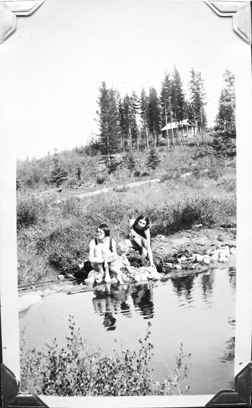 |
|||||||
|
A customer who couldn't pay a whopping $35 bill offered, in exchange, a new dining table, eight chairs, and buffet bought for $35 from from Eaton's catalogue. Grandma and Grandad agreed Five generations have enjoyed meals around this table: Grandma's
parents when they visited; Grandma and Grandad; Dad, from age five, and
Mom from her teens on; me, since birth, with my siblings, then my husband;
and now our kids. |
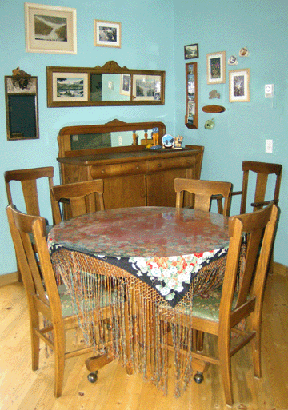 |
The walls and buffet top have Cavell mirrors and memorabilia, and Jasper photographs. Only six chairs returned to Jasper from North Vancouver in 1945 - no more room in the truck.
Grandad collected plaques with funny sayings. This was a favourite. We could guess who he had in mind.
|
|||||||
|
|
While at Pedley, Grandad invested some savings in foothills' coalmining, but the business didn't take off, and he lost it all. With no cushion and no end in sight to hard times, it made sense to move back to Jasper. They returned to town in 1936, when Dad was five and ready to attend the Jasper school - a fine building with good teachers. Grandma could substitute, which she did occasionally, but as a married woman, couldn't become staff. Grandad immediatedly built another small log house for his family, this time on Patricia Street. Eventually, it became the town's "little drugstore", next to the fishing shop. As a kid, I bought candy from a rack where their living room had been. We picked up prescriptions from the former kitchen area. |
||||||||
|
Dad's letter from the farm, 1939 He writes the next year > |
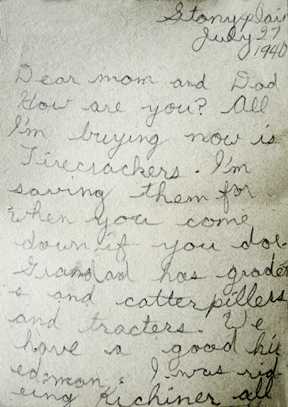 |
Dad continued to spend his summers at Grandma and Grandad McKinlay's farm in Stony Plain. Grandma kept a number of his letters. They're funny to read, because of Dad's enthusiasms and lively take on farm activities. From 1939-40, I taught Sunday school at the United Church (where I belonged to the Pioneer Group from 1936-72, there being no Presbyterian church in Jasper). From 1941-42, I was the Registrar of Vital Statistics for the Registration District of Jasper. When war broke out in Europe, Don was unable to enlist in the armed forces, so we closed shop in Jasper in May of 1942 and were off to the North Vancouver Ship Yards, where he did the finishing work on the captains' cabins. Don went to the coast in June, then Gordon and I went out in September. Don came back to get us. |
|||||||
|
There were no places to rent in North Vancouver, so we took up at 2044 Mahon Avenue, and Don built a five-room bungalow over our heads during nights and weekends. |
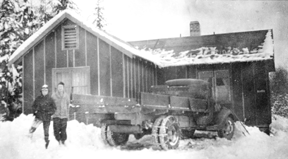 Dad and Grandma at the back of their new home, woodframe this time, not log. |
From May 22, 1942 to June 30, 1945, he worked on 52 freighters, as well as several Russian ships in the harbour for repairs. Wages for carpenters were pegged at $1.00 an hour, and quitting was not allowed. Don earned $68-72 every two weeks, at first spending much of it on lumber (eg. $50 - $18 left to live on) . The summer of '45, when Gordon was 14, he was able to make twice as much with the Insulation Department of the Vancouver Ship Yards than his dad made as a carpenter. |
|||||||
|
He and his best chum led the Drum and Trumpet Band. They travelled to Seattle for a war rally of many bands. One Friday, I scraped together small coins to make 25 cents for a pound of hamburger. Gordon got it, then on his bike back from the shop, fell off, dropped hamburger, dog got it, and ran away. Dad followed and searched, came home empty-handed and crying - no meat till his dad was paid on Monday. |
|
||||||||
|
They returned to Jasper in their old, overloaded truck. They had to leave two dining chairs behind. In 1945-46, Grandad built another home for his family in Jasper, on Connaught Drive, across from the CN station. We have very few photos of it, outside or in. It was woodframe, lathe & plaster, with a flat roof, small false front (to match some of the other main-street buildings), and stucco finish. Dad was big and old enough to help build it - the start of his carpentering career. The stone trim was the same as on Spero's candy store, restaurant, and dance hall. They must have been built at the same time. Both buildings are long gone now. The house was small, but it had three bedrooms (one, my starting place) and a narrow office space that fronted on the main street. Grandma could use this or rent it for commercial purposes, which she did on and off, but not continuously. |
Dad with Grandma and Grandad McKinlay in 1946, in front of the new house. Grandma wrote on the back of the photo that he was a happy boy, back home in Jasper. |
Grandma's large laundry/sewing room at the back was her operations' central, when not running Cavell Chalet. She was a whirlwind housekeeper on a strict schedule, and she was a prodigious maker of handiwork of every sort - always knitting, crocheting, embroidering, sewing, tatting, cutwork .....
Embroidered bride, in a blue-mauve dress, which hung with another lady in yellow in the guest bedroom. Grandma's plastic laundry sprinkling lady, to dampen Tuesday's ironing. |
|||||||
|
Chalet Moraine had been closed for six years during World War II, when gas rationing limited the tourist trade. During that time, the Lovatt Scouts Regiment from Scotland was billeted at the Chalet; two- and four-legged packrats invaded and damaged the building. The troops used the nearby glacier for target practice too, which cause it to recede at many times its normal rate. |
The charming little tea house Grandma and Grandad bought. |
We took off the original veranda, for more light in the building, replaced the small-paned windows with large ones, put a natural gas heater in the basement, added rooms upstairs to rent to hikers and tourists, and built on a souvenir shop. |
|||||||
|
Veranda gone, moraines next. The place got got ever more austere ... |
Don continued doing carpentry work during the winter, and he occasionally double-shifted at the Chalet and construction during the summer. |
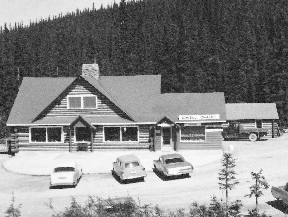 ... to serve ever more tourists in a rush. |
|||||||
|
Don loved the Cavell area, particularly the hike to the alplands, with its carpet of flowers and abundance of wild animals such as caribou, which summer at Cavell and winter in Tonquin Valley, as well as marmots, rock rabbits, ptarmigan, golden-mantled ground squirrels, and Clark's nutcrackers, which one could feed by hand. We sold unroasted, unsalted peanuts - ½ ton per year - to the tourists, so they could give our little friends healthful food, which we were assured was so by three university animal science departments. |
Grandad, ca. 1960 |
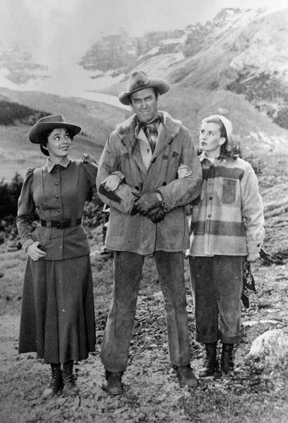 |
|||||||
Ruth Roman, Jimmy Stewart, Corinne Calvert > |
|||||||||
|
One time, tiring of the press and the repetition, Grandad pointed to his hearing aid and shook his head, as if he couldn't hear. "Oh, the poor man's deaf!" said the woman who'd asked him. He then pointed to his mouth, to indicate that he was mute, and then to his eyes, as if he couldn't see. The woman exclaimed loudly, to inform everyone in the building, "Oh dear, the poor man's deaf, dumb, and blind!" To the right is a view Grandad knew well, looking down at the Chalet from the hike up to the alpine meadows. He kept a "trap line" on a back route up, stops on the way where he stashed mickeys of rye. |
They started before sunrise, climbed the ridge to the top (where they located the 25-pound cross Hans had carried up on an earlier ascent), and descended all in one long day. Don was nearly 56 years old - quite an achievement. |
||||||||
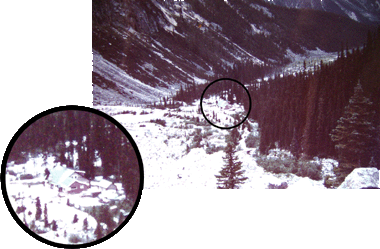 |
|||||||||
|
Don became a proud member of the Alpine Club of Canada that year. He was also a member of the Jasper Park Masonic Lodge #173 and the Excelsior Chapter #60 O.E.S. Jasper. We had many interesting guests overnight. Mr. Simpkins, who drew Jasper the Bear cartoons for MacLean's magazine, was the guest of honour at a dinner party we hosted for him and the Park Superintendent, then he stayed overnight with his wife and son. He did sketches on onionskin paper of my grandchildren, plus a cartoon of his famous bear, which remain treasured, if crumbling, mementos. |
His and Han's view down, and across to Throne Mountain, shown on the left from the Cavell road. |
Grandad on top. From the Chalet, we could see him and Hans (very tiny) through binoculars as they climbed the ridge. |
|||||||
|
Grandma and Grandad travelled to Florida and California that fall, after closing up the Chalet for the winter. On the way back from their trip, they visited Mae Guild Barrett [link to a page about her], who taped a message from them. This was a novelty in those days. They wrote out their pieces, which I have, but the recording is lost. We have volumous amounts of Grandma's handwriting, but only this, plus a few work-related snippets, of Grandad's. |
|
||||||||
|
Simpkins' sent "Jasper the Bear" Christmas cards for several years. |
At the Chalet, other guests included: the Ambassador of Russia, with
his family and attendants; an artist from Japan, who could communicate
with one of my staff, Janice Herzog, who knew sigh language; Princess
Alice and her Lady-in-Waiting, who had tea on a sightseeing stop from
the Jasper Park Lodge; Australian, English, European, American, and of
course, Canadian tourists who stayed overnight, whom we got to know quite
well, because we were a small operation. Many Christmases, I sent over
600 cards to Chalet friends around the world.
|
||||||||
|
Typical expressions, Grandad looking amused, and Grandma ready for business. > Grandad often had this expression as he turned off his hearing aid. If he was tuning out Grandma, she'd shout so loud that he said, "they hear her to Edmonton." When I was about three, I asked Dad, while Mom was shouting at him, why didn't he just turn down his "hearing egg" like Grandad did? |
1960 July. Brother-in-law Jack Hargreaves built the fireplace in 1929. The wooden candlestick, one of two on the mantle, was at Chalet Moraine when it opened. |
He'd said occasionally in his 50s that he didn't want to live past 60, because he wouldn't be as physically capable as he liked to be. On August 14th of 1966, he shook my brother's hand in town, said he was heading back up to Cavell, and that he'd never see him again. This was upsetting, of course, but came to be. In exactly a month, Grandad was gone. |
|||||||
|
Grandad was a meandering driver at best. We'd worried for years that he'd drive off the Cavell road at a switchback and plunge hundreds feet to the valley below. He died, however on the one straight stretch, about half-a-mile long, not far from the Chalet. He'd taken off in a rush, dropping his job of boarding up the windows for the winter, not something he'd do without good reason. Grandma was in the Jasper hospital at the time, with a bad flu. She left the hospital that afternoon, driving to pick up something, then returned in a rush, sick as a dog. Shortly after, she got word of Grandad's sudden end. She thought perhaps he'd had a heart attack at the chalet, which recurred as he raced down the road for help. He'd swerved into a tree, hit his head on the windshield, and his truck caught fire, half cremating him. |
|
||||||||
|
"Auf Wiedersehen" |
||||||||
|
Another souvenir-shop keepsake, a dancing-bear music box. Grandad loved it! It was for cigarettes, but he didn't smoke, so he kept mints and butterscotch drops in it. The tune is the "Sirens Waltz". It's whimsical and wistful, like Grandad, and tugs the heart as it slows, then stops before the tune is over. |
Grandad sold many Hummel figurines when he worked in the chalet
souvenir shop. Grandma kept the "Little Hiker" for her Don and this one
for herself. >
|
||||||||
Family and friends helped me run the Chalet, both before and after Don's passing: my mother and dad came up from Edmonton (where they'd retired from their Stony Plain farm), with Mom managing the souvenir shop; son Gordon helped keep the building in good repair. Daughter-in-law Marion often came before summer staff arrived and after they'd left in the fall. Friends Bernice Slinn, Nina Findley, and Laura Stevenson each spent five summers in the souvenir shop, which was a blessing, as I liked to work behind the scenes. |
|||||||||
|
Grandaughter Brenda ran the Chalet for six weeks in June and early July of '71, while I toured as the O.E.S's Worthy Grand Matron of Alberta. |
 |
||||||||
|
More to come, |
|||||||||
|
|
|||||||||
|
|
|||||||||
![]()